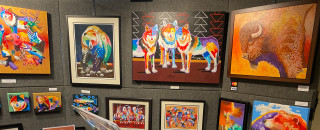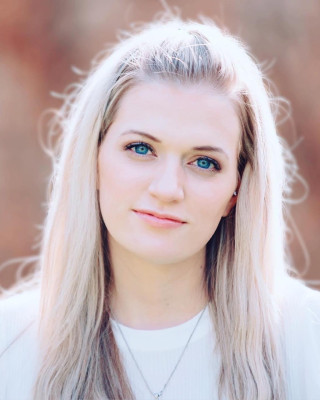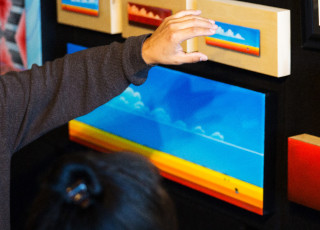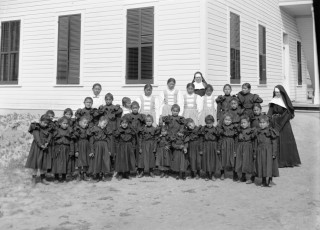Identity, Artistic Exploration, and NHMU’s Indigenous Art Market
By Olivia Barney
NHMU’s Indigenous Art Market returns this weekend, bringing talented Native American artists from across the United States to the foothills of Salt Lake City, Utah. The market is an exciting, two-day event that also features dance and music performances in an immersive celebration of Indigenous art and culture. Participating artists showcase and sell their art, giving visitors a chance to purchase one-of-a-kind jewelry, pottery, sculptures, paintings, beadwork, weavings, and more. The best part? All sales stay with the artists.
For more than a decade, the Indigenous Art Market has brought creatives together, and each of these artists is completely unique. Some create more traditional art, others lean toward a contemporary style, and many depict a hybrid of the two styles, creating a sort of stylistic fingerprint that’s unique to them.
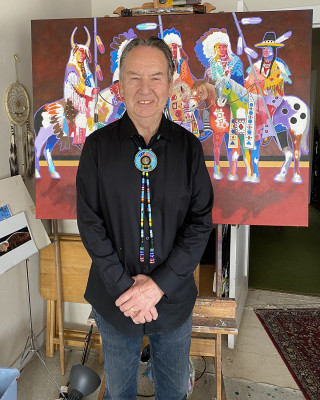
John Balloue in his studio.
In anticipation of this weekend’s event, the Museum sat down with artist John Balloue, a member of the Western Band of Oklahoma Cherokee, who is returning to the market for his third year. John has explored a wide range of styles over the course of his artistic career, calling his work as a painter “part learning about [his] heritage and part keeping it alive.”
Native Heritage and Urban Life
Growing up on the West Coast of the United States, John Balloue couldn’t help but feel a bit disconnected from his Cherokee ancestry. Sure, he spent time visiting family in Oklahoma and learning about their cultural heritage. He walked the land his ancestors walked. He knew the Balloue family name was synonymous with an entire community of people and places—a living history of their family’s influence. And yet, John still felt somewhat distant from this rich legacy.
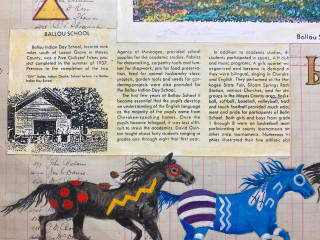
A newspaper clipping of the Ballou School.
That disconnect didn’t only come from growing up outside of the reservation, roughly 1,700 miles away from Oklahoma. Even as a child, John remembers struggling to understand his identity in little things, including his appearance.
While John’s father was Cherokee, his mother was of English/Irish descent. And as far as physical features were concerned, John took after his mother. His reflection in the mirror was a reminder of the different parts of his ancestry: seemingly opposite worlds existing in one person. But as John began using art as a method of exploring and expressing his Indigenous heritage, bridging those worlds became easier.
Traditional Stories, Contemporary Expression
John originally aspired to become an architectural draftsman, but his plans changed while taking art classes at the local junior college. He laughed as he recounted the memory: “I took to it like a fish takes to water. It was something I had a knack for.”
He certainly did.
Suddenly pursuing a BA in Art at California State University, Hayward (now California State University East Bay), John spent countless hours in museums, pouring over the pages of books, and practicing his technique. He emphasized the importance of young artists grasping the fundamentals, because those key techniques will become a “foundation for finding and expressing your own voice” down the line.
These fundamentals shine across John’s portfolio of work, even when his personal style changed. John’s art journey has encompassed photorealism, vibrant, experimental expressionism, and most recently, abstract pseudo-cubism. He described this shift in artistic style as an effort to connect with his heritage, express emotion, and have fun. His most recent pieces incorporate abstract elements to allow viewers to “fill in the blanks,” connecting with the piece and making meaning for themselves. This kind of personal connection is exactly what John hopes viewers will experience when interacting with his art.

Paintings by John Balloue
John sought this artistic connection himself. He longed to honor his ancestors and make them proud. But recognizing his identity as a Cherokee artist didn’t come all at once. John described moments of this journey like they were snapshots in a photo album. He began painting portraits of his Cherokee relatives and incorporating the places he’d seen and the stories he’d been told. In those early days, John sought out his father’s approval on every piece. Sure, he wanted a father who was proud of his work, but it was more than that.
The people, places, and traditions that John was putting on canvas were personal. They would become public representations of their family, heritage, and beliefs. John wanted to do it right.
Though being far from Oklahoma sometimes led to feelings of disconnect, John kept painting the stories that had been passed down to him. Over time, he grew more confident and gave himself permission to paint these scenes as he interpreted them. He found his voice the same way he embraced his identity—little by little. But that exploration of his heritage isn’t finished. Even now, John sees each project as an opportunity to learn a little more about who he is and the legacy that he carries.
Traditions Enduring
The Cherokee phrase "going to water” references a sacred ritual for healing, cleansing, or guidance. It is so central to their culture that John can recall his grandmother repeated the phrase often.
It involves going to the river early in the morning and facing the rising sun. Sometimes people pray for the spirits to guide them. Other times they ask for spiritual cleansing or physical healing. “Going to water” is a sacred, reverent experience that John wanted to capture in his art.

"The Prayer," a painting by John Balloue.
His piece, “The Prayer,” depicts this scene. A man kneels beside the water in prayer, seeking wisdom from the spirits of the natural world. The smoke from his pipe billows outward and forms the subtle silhouettes of a bison, eagle, and wolf. Each of these animals is considered sacred and wise to the Cherokee, so their presence indicates an answer to prayer. The spirits are listening. They are ready to guide.
This weekend, John will be selling original paintings and unframed prints, as well as coloring books, calendars, and notecards that depict some of his most brilliant, colorful work. I asked John if he had any favorite pieces, but he just shook his head. “Some pieces are like children; others are like a capsule of time that remind me of who I was when I painted them. They are the people I knew and the places I experienced.”
The Indigenous Art Market is included with regular museum admission, but you can save time and skip the lines by reserving your tickets in advance.
